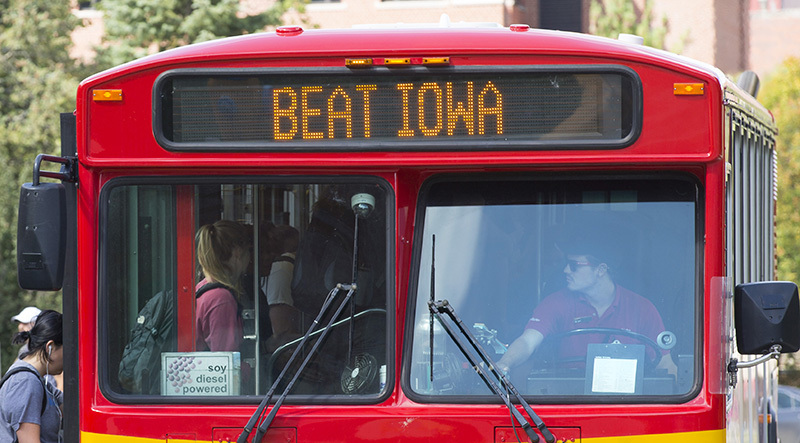You have arrived
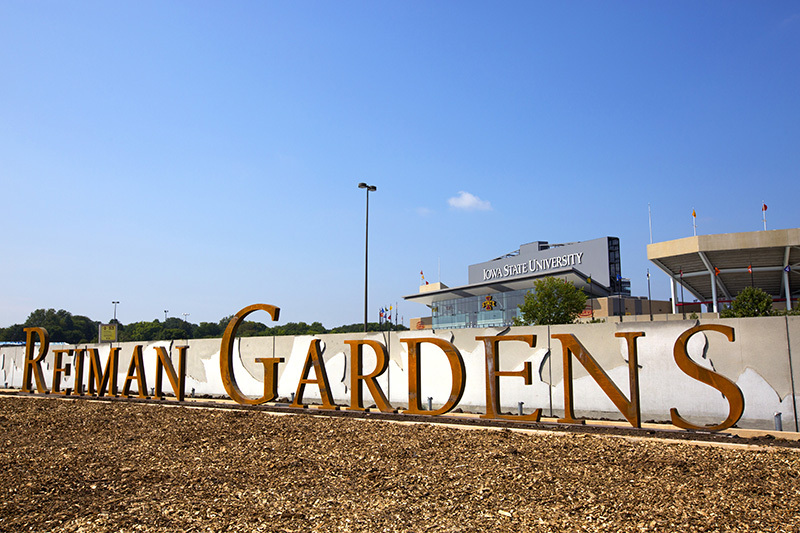
Photo by Christopher Gannon.
Visitors traveling to Reiman Gardens will have an easier path to follow, thanks to the addition of entrance signage installed last month. The steel lettering -- ranging from 3 feet 4 inches to 5 feet 5 inches tall -- stretches over 52 feet, making the gardens entrance more visible from University Boulevard. A concrete wall with a leaf motif serves as a backdrop.
Bob Catus, interim manager of construction services in facilities planning and management, said the concrete element is tied to the architecture of the buildings in the Iowa State Center complex. Lights will be added next spring to create a nighttime silhouette of the lettering against the wall.
The new entry area also sports monument columns and fencing, both scheduled for completion this fall. Landscaping will be added later this fall and next spring. It's all part of a multiphased project that began in 2014 and included improvements in and around the stadium.
Related stories
- Project update on the stadium south green space, Aug. 31, 2017
- Work resumes on south stadium green space, July 6, 2017
- Stadium-gardens link improvements begin, March 31, 2016
Fall enrollment is second highest on record
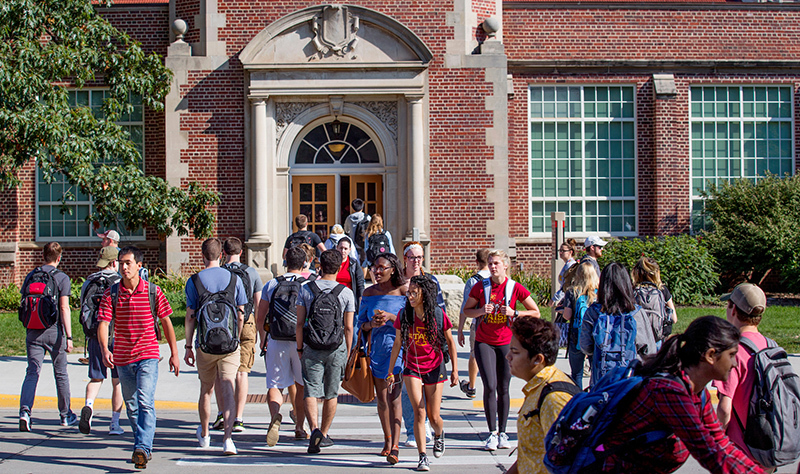
Students come and go from Physics Hall during the first week of fall semester. Photo by Christopher Gannon.
Iowa State's fall 2017 enrollment is 36,321, the second-largest in school history.
Overall enrollment at Iowa State is down about one percent from last year's record of 36,660 students. The new student body number reflects a "leveling off" university leaders have predicted over the past year, following a decade of growth and eight consecutive years of record enrollment at Iowa State.
"This year's enrollment is more manageable, but it remains a very substantial number," interim President Benjamin Allen said. "Additional resources are needed to maintain our top-ranked programs and the high educational quality for which Iowa State is known. We continue to operate with significantly less state support, and significantly more students, than a decade ago."
Where they come from
Iowa State's student body represents all 99 Iowa counties, all 50 U.S. states and 127 countries. International enrollment is 4,115, down just 16 students from 2016's record 4,131.
This fall, 19,843 Iowans are attending Iowa State. They equal nearly 55 percent of the overall student body and 60 percent (or 18,246) of the 30,406 undergraduates. Iowa State continues to enroll more Iowans than any other university in the world.
Nearly 95 percent of Iowa State graduates are either employed or pursuing further education within six months of graduation.
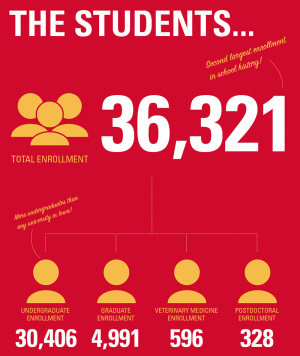
More details are available on the full infographic.
About the Class of 2021
- Iowa State's new freshman class of 5,944 students includes 3,174 Iowans.
- They have an average ACT score of greater than 25.
- More than a quarter of Iowa State's incoming freshmen ranked in the top 10 percent of their high school graduating classes.
- Their average high school GPA was 3.61.
"This is an impressive class, reflecting Iowa State's strong reputation in Iowa, across the country and around the world," Allen said. "It's a testament to our high-demand programs and the overall student experience we provide."
Record diversity
Total U.S. multicultural and international enrollment at Iowa State is 8,789, or 24.2 percent of the student body -- a new record exceeding last year's number of 8,748.
U.S. multicultural enrollment is a record 4,674, up 57 from last year's total of 4,617. Undergraduate U.S. multicultural enrollment is also a record – 4,171, up 78 from last year's total of 4,093.
Other records
Professional (veterinary medicine) enrollment is at a record 596, up from last year's 586 students. Veterinary medicine total enrollment is 765.
Nonresident enrollment is 12,363, a new record – up 854 over last year's total of 11,509.
Fall 2017 enrollment by college
|
Agriculture and Life Sciences |
5,333 |
|
Business |
4,921 |
|
Design |
2,039 |
|
Engineering |
9,669 |
|
Human Sciences |
4,640 |
|
Liberal Arts and Sciences |
8,284 |
|
Veterinary Medicine |
765 |
|
Interdepartmental units and graduate undeclared |
342 |
|
Postdocs |
328 |
|
Total |
36,321 |
More than 60 applicants considered in presidential search
Presidential search committee co-chair Luis Rico-Gutierrez said he's pleased by the quality and size of the pool of candidates seeking to be Iowa State's next president.
Rico-Gutierrez, dean of the College of Design, told the state Board of Regents on Thursday that the search committee is reviewing applications from a little more than 60 people. More than 100 candidates were nominated, he said.
The committee received the applicant materials last week, after the Aug. 24 deadline for best consideration. Rico-Gutierrez said he's still working his way through the applications, but he likes what he's seen so far.
"I think of few of those have potential," he told the regents.
More detailed information about the candidate pool will come out at the search committee's meeting Tuesday, Sept. 12, when the committee will pick which applicants to interview, he said.
That discussion, and the semifinalists selected, will be confidential. Discussion of how to translate the lengthy position description into semifinalist questions will be public, however.
In an interview earlier this week, Rico-Gutierrez said he'll be looking for a candidate who can nurture an environment ripe for academic opportunity and knowledge creation as well as support the university's infrastructure, including a track record of securing external funding. A familiarity with Iowa State's land-grant mission will be especially important, he said.
"This is, for me, the defining factor of this position," he said.
Committee members will interview an estimated 10 to 12 semifinalists at an off-campus site Sept. 26-27. The number of finalists -- possibly as many as five -- may be disclosed afterward, but finalists won't be named publicly until the day before their on-campus interviews, slated for the week of Oct. 9.
When the presidential prospects visit Iowa State, they will answer questions from the public in on-campus forums. Rico-Gutierrez encouraged those interested to participate and offer written feedback. It's an important aspect of the search that creates a bond between the campus community and its new leader, he said.
"In many ways, the presidency begins there," he said.
Rico-Gutierrez said the search is a special opportunity, noting the relative rarity of turnover. Iowa State's 16th president will assume office in the same year the university celebrates its 160th anniversary. He also praised the 21-member committee for its commitment.
"They understand how important this is," he said. "The president position is the one position at the university that impacts absolutely everybody. Students, faculty, staff, alumni -- everybody in one way or another relates to the activities of the president. So I just hope everybody helps us find the right person."
In a special meeting set for Oct. 23 in Ames, the regents will receive the search committee's recommendation, interview finalists and select Iowa State's next president.
Former President Steven Leath left Iowa State to be president of Auburn University last spring. Interim President Benjamin Allen has been leading the university since May and will continue in that role until the president begins her or his tenure in early 2018.
Related stories
- Presidential search shifts to next phase, Aug. 24, 2017
- Search is on for Iowa State's next president, July 6, 2017
- Iowa Staters talk about their next president, June 15, 2017
- Presidential search timeline will match 2011 search, April 27, 2017
- Presidential search will be open, March 30, 2017
- Leath takes top job at Auburn University, March 23, 2017
December commencement will return to two ceremonies
For the first time in eight years, Iowa State will hold two commencement ceremonies to honor students completing degrees during fall semester. A Graduate College ceremony will be held Friday evening, Dec. 15, and an undergraduate commencement ceremony will be held Saturday afternoon, Dec. 16. Both events will be at Hilton Coliseum to ensure unlimited seating for family members and friends.
In 2010, the university combined two December ceremonies into one.
Fall commencement ceremonies
Graduate College
- Friday, Dec. 15, 7 p.m., Hilton Coliseum
Undergraduates
- Saturday, Dec. 16, 1:30 p.m., Hilton Coliseum
Interim university registrar Jennifer Suchan said the intent is to offer a better, more meaningful experience for students and their families. The change, she noted, is a logical response to recent student trends, including:
- Eight years of steady enrollment growth
- Climbing student retention and graduation rates
- A higher percentage of graduating students who opt to participate in a university ceremony (not only a college convocation)
One outcome of all those positive trends was a December commencement ceremony that became increasingly long, last year exceeding three hours, Suchan said. In splitting it into two events, the goal is to host a 90-minute graduate ceremony and a two-hour undergraduate ceremony. That should enhance the commencement experience for both graduating students and their guests, she said.
Summer of vetting
During a May meeting of the university's commencement advisory committee, Suchan proposed separating the December event into two ceremonies -- with mixed feelings.
"As an institution, we see great value in having all of our students at one event, thereby allowing our undergraduates to envision themselves as graduate students," Suchan said.
Over the summer, advisory committee members continued to assess options and talk with stakeholders. Making adjustments, it sought and received approval for this plan, including from leaders in the Graduate College and provost and president's offices.
"We're excited about this change. We think our graduates and their families will enjoy the experience," Suchan said.
Stay tuned
Suchan said the commencement advisory committee is in a similar process of evaluating changes to the structure of the spring undergraduate ceremony, which moved outdoors to Jack Trice Stadium two years ago and lasted about 3.5 hours last May.
Wellbeing advice at your fingertips
Iowa State employees who want to live their best lives have access to a new online tool to help accomplish their goals.
On Sept. 6, ISU WellBeing launched Adventure2, a wellbeing portal available to all ISU benefits-eligible employees. The name is a nod to the university's admissions theme, "Choose Your Adventure," with the idea that faculty and staff may live their adventure while teaching, researching, advising, cooking, cleaning or doing whatever they are hired to do.
"The idea behind the name and the entire program is about living your best life, having that adventure at ISU," said Stephanie Downs, ISU WellBeing coordinator.
University human resources (UHR) partnered with Limeade, a Seattle-based corporate wellness company, to develop the portal. Limeade offers multiple libraries of wellness information that Adventure2 taps into. The company also helped UHR develop custom topics and programs for Iowa State, and manages the site's technology, support and security.
Access and features
Adventure2 is accessible from computers, smartphones and tablets. To get involved, go to the ISU WellBeing website and click on the "Adventure2" tab. Log in with your ISU Net-ID and password.
Employees may access dozens of links related to ISU WellBeing's core elements – mental, physical, spiritual, emotional, financial and community. Downs encourages employees to, at a minimum, read and browse these topics. But employees who want to take their wellbeing a step further may track progress toward their goals using a three-tier points system. Here's how it works:
For almost every activity completed, you earn points (available points are listed on each activity). Activities run the gamut, from attending a professional development seminar to taking part in a campus walk to practicing relaxation breathing. Employees also earn points for having annual physicals or completing enrollment forms during the annual benefits election period. Employees may accumulate enough points to achieve one of three recognition levels. They are:
- Dare Greatly (1,000 points)
- Live Well (2,500 points)
- Soar Confidently (5,000 points)
With each level earned, employees receive recognition and awards, including a special banner for their email signatures designating which level they've achieved. Points are accumulated by calendar year and don't carry over from year to year. New challenges are launched and point levels are reset at the end of each programming year.
Employees may earn points individually or through team challenges. In all cases, participation may be kept anonymous through a public-private toggle button on each activity page.
"This is the part of the system that incorporates social media because employees can post messages, such as 'good job' or 'let's do this,' related to the challenge if they want," Downs said.
Assess yourself
One way to ramp up points in Adventure2 is to take the wellbeing assessment, though it's not required to participate in the points program. The assessment examines six categories:
- Reaching your potential
- Emotional wellbeing
- Physical wellbeing
- Capacity for change
- Work
- Health risks
The assessment takes about 20 minutes to complete, and employees can stop and resume as often as necessary. Once complete, employees immediately will learn the top three areas they can work on and the top three things they are doing well. A list of links related to the categories is included.
"This system is about sharing positive feedback with employees," Downs said. "It helps motivate people to continue working toward their goals. It's a fun support resource."
Learn more
Downs encourages employees to bring their laptops, tablets or smartphones to the Sept. 12 Professional and Scientific Council seminar (2-3 p.m., Memorial Union Pioneer Room), where she will demonstrate how Adventure2 works. Employees will be encouraged to log in and follow along.
Employees already on the portal site may get help by clicking on the gray feedback button located on the upper left side of any page. Limeade provides user support. If employees have questions specific to Iowa State, they may contact Downs directly.
Now that Adventure2 is up and running, Downs hopes employees explore the tool to reach their full potential.
"This is meant to be a support program that motivates people," she said. "It's here for you because the Iowa State community cares about you and your wellbeing."
Research is at heart of grad student writing center
At the Center for Communication Excellence, graduate students assist their peers in writing better with techniques and training grounded in data.
The center, housed in the Graduate College in Pearson Hall, held 1,347 one-on-one mentoring sessions last year, part of an array of ways it helps graduate students and postdoctoral scholars hone their communication skills.
"I have used the CCE to assist me with my writing and I feel it has been the best experience and peer support I ever had at ISU," a graduate assistant in English wrote earlier this year in support of the center's proposal for new computers.
Students aren't the only benefactors. The center also is helpful for faculty, who often can't provide a similar level of individualized attention to graduate student writing.
"It alleviates some of their burden," said assistant director Sarah Huffman, one of the center's two full-time staff.
Here are a few things to know about the center, which is embarking on its third school year this fall:
Data-driven
The center, formed as the result of a task force that explored how to improve graduate student writing, is research-based.
"We have a lot of research projects that are ongoing that then feed into the development of materials," director Elena Cotos said.
Before they begin working with students, peer mentors take a three-credit course, a hands-on immersion in mentoring strategies and providing critical feedback that involves observing existing peer mentors and mock training scenarios.
"This is pretty unique," Huffman said.
After each consulting session, student clients fill out a survey to assess the assistance they received, data that's used to continually shape the program, Huffman said. The center also conducts weekly ongoing training for its consultants.
Common conventions
Research into similarities in academic writing conventions across numerous areas of study also informs the center's practices. Cotos and Huffman studied collections of publications from 30 varying disciplines to identify common constructs in research writing as well as discipline-specific conventions.
Even as peer mentors gear their advice toward specific norms in a given discipline, they draw on conventions applicable across areas of study, a model that's at the foundation of the center's programming.
That research also is the basis of the center's research writing tutor, an online tool that gives an automated analysis of student research writing.
"It actually gives feedback on every single sentence," Cotos said.
How it works
The free sessions at the center cater to all manners of academic writing. Consultants work with writers at any stage of a project, from brainstorming and outlining to polishing a finished section or incorporating faculty feedback.
Appointments are booked online, and sessions are generally in-person.
In addition to interdisciplinary consultants, the center offers consultants in general English writing for international students, online consultants for distance students, consultants for dissertation and thesis work, and discipline-specific consultants in agronomy and agricultural and biosystems engineering. Chemistry consulting sessions will start this spring, Huffman said.
In 2016-17, peer mentors consulted with 532 students from 44 academic departments. Fifty-nine percent of students seeking support were nonnative English speakers.
Sixty-nine percent were doctoral students, and 29 percent were seeking master's degrees.
Other support
The focus isn't solely one-on-one help.
Trained facilitators lead groups of graduate students who review each other's writing. Peer mentors are embedded in some writing-intensive graduate courses. Plus, the center has held boot camps for students working on a thesis or dissertation, seminar series on various writing needs and one-minute reviews of job application materials at the Graduate Professional Student Senate annual conference.
New this semester, the center has an English-speaking consultant to help improve the verbal skills of both nonnative and native speakers. That dovetails with courses in oral communication for international teaching assistants the center administers.
Cotos said she takes pride in the center's flexibility and is always interested in new collaborations.
"We're really open and looking for opportunities to engage with students in different venues," she said.
President's address is Sept. 14
The university community is invited to interim President Ben Allen's fall address on Thursday, Sept. 14, in the Memorial Union Great Hall. Doors open at 6 p.m., Allen's remarks will begin at 6:30 p.m. and light refreshments will be served afterward.
Allen will discuss his priorities for keeping the university moving forward during this time of transition. He will touch on state funding challenges, Iowa State's multiyear tuition proposal, campus climate and safety initiatives, and fundraising milestones.
All are welcome. For those unable to be at the Memorial Union, the address will be livestreamed.
Iowa State is an NSF Innovation Corps site
Iowa State has been selected as a National Science Foundation Innovation Corps (I-Corps) site, a distinction that enhances the university's reputation as a leader in creating innovative solutions to societal problems. The office of the vice president for research and the office of economic development and industry relations (EDIR) are partners in developing Iowa State's I-Corps program.
An I-Corps site acts as a training ground for faculty, postdocs and graduate students to transition their ideas from the laboratory to the marketplace. Researchers will explore the commercial potential of their research and technology as a means to increase its impact. In addition, the program will strengthen the university's entrepreneurship programs.
Learn more: info sessions
- Sept. 11, 9-10 a.m., MU Gallery
- Sept. 12, 9-10 a.m., MU Pioneer Room
"The I-Corps award further advances our culture of entrepreneurship and innovation by increasing support for students and faculty in translating research findings into value-added products in the marketplace," said Sarah Nusser, vice president for research. "We are particularly pleased to strengthen the bridge between research discoveries and the potential to develop new start-up companies that increase the impact of our research."
Associate vice president for research Guru Rao is the principal investigator for the I-Corps project. Co-principal investigators are Kristine Johansen and William Adamowski, EDIR program managers who cultivate relationships with industry and run the Startup Factory.
Iowa State's focus
Iowa State is among the top universities in the world to be granted U.S. utility patents. As an I-Corps site, the university will focus on translating discoveries that reflect its strengths in engineering, biorenewables, materials science, agriculture, food and nutrition, and veterinary medicine. The program is expected to bolster entrepreneurship and innovation already happening across campus, foster connections with other Midwest I-Corps sites and strengthen the nation's innovation fabric.
How it works
Each year, ISU teams will compete to participate in the program. Thirty teams will be selected, each containing:
- An entrepreneurial lead (grad students or postdocs)
- Academic lead (faculty)
- Mentor (emerging entrepreneur)
Teams will receive instruction on the principles of starting a new business, writing proposals, understanding intellectual property, defining outcomes and delivering compelling presentations to potential customers -- all with an eye toward starting a new company. Microgrants are available for accepted cohort members. I-Corps will work with existing entrepreneurial units at Iowa State, including resources within EDIR.
Learn more
Interested faculty, staff, post-docs and graduate students are invited to learn more about the program during two information sessions next week in the Memorial Union. Each session will cover a program overview, application process and timeline, curriculum overview and benefits of participation, including additional funding and program opportunities. The sessions are:
- Sept. 11, 9-10 a.m., MU Gallery
- Sept. 12, 9-10 a.m., MU Pioneer Room
"Iowa State's research infrastructure, combined with our collaborative team approach and innovative spirit, provides the perfect setting for researchers to explore the commercial potential of their discoveries," said Michael Crum, vice president of economic development and industry relations. "Being an I-Corps site also enables us to provide even more real-world, hands-on, immersive learning experiences for our students and further establish ourselves as a leader in launching and growing successful enterprises."
Leadership program has new directors, updated programming
Twenty-four faculty and staff are participating in the 2017-18 cohort of Iowa State's Emerging Leaders Academy (ELA).
ELA is an academic-year initiative to better prepare a diverse group of faculty and professional and scientific staff currently serving in leadership roles or who aspire to hold leadership positions. Participants attend monthly sessions on topics in leadership theory and practice, communication, formal presentation, understanding environment and culture, budgeting and resource management, performance management and ethical leadership. The 2017-18 ELA class is the program's seventh.
New program leaders
Dr. Rod Bagley, professor and chair of veterinary clinical sciences, is the program's new faculty director. Bagley teaches communication, career development and ethics in the veterinary professional curriculum and has led development programs on the subjects of communication, professional leadership/management and performance management. He takes over the ELA curriculum responsibility from John Schuh, who led the program for four years and retired last spring.
Katharine Hensley, faculty professional development coordinator in the office of the senior vice president and provost, will co-direct the program, with a focus on representing the perspective of P&S staff.
"Helping to accompany these current and future university leaders on their leadership journey is both a great opportunity and a great responsibility," Bagley said. "Ultimately, we want to help create opinion leaders who have broad knowledge of Iowa State's mission, vision and operations, and who are prepared to fulfill their leadership roles effectively and positively impact the future of the university."
Team service projects added
ELA sessions are held at locations around campus to foster a deeper understanding of the university and its mission. For the first time, as part of their capstone experience, class members will complete service projects for the university community that must align with the university's strategic plan and Principles of Community. Projects will be completed by May 2018.
Applications for the 2018-19 ELA program will be available in the spring.
Roster
Members of the 2017-18 ELA cohort are:
- Lorenzo Baber, School of Education
- Billy Boulden, dean of students office
- Susan Bradbury, community and regional planning
- Eric Burrough, veterinary diagnostic and production animal medicine
- Simon Cordery, history
- Jake Cummings, equal opportunity office
- Kristie Franz, geological and atmospheric sciences
- Nancy Gebhart, university museums
- Nathan Hannover, information technology
- Audrey Kennis, College of Design student support services
- Stacy Kilstofte, College of Liberal Arts and Sciences administration
- Lindsey Long, athletics
- Peter Martin, human development and family studies
- Cathy Miller, veterinary microbiology and preventive medicine
- Melissa Miller, office of the vice president for research
- John Nason, ecology, evolution and organismal biology
- Dan Nutini, facilities planning and management
- Angela Powers, Greenlee School of Journalism and Communication
- Jacquelyn Rees Ulmer, supply chain and information systems
- Stacy Renfro, Center for Statistics and Applications in Forensic Evidence
- Cris Schwartz, mechanical engineering
- Laurie Smith Law, Honors program
- Javier Vela, chemistry
- Sean Whalen, Ames Laboratory
It's rivalry week
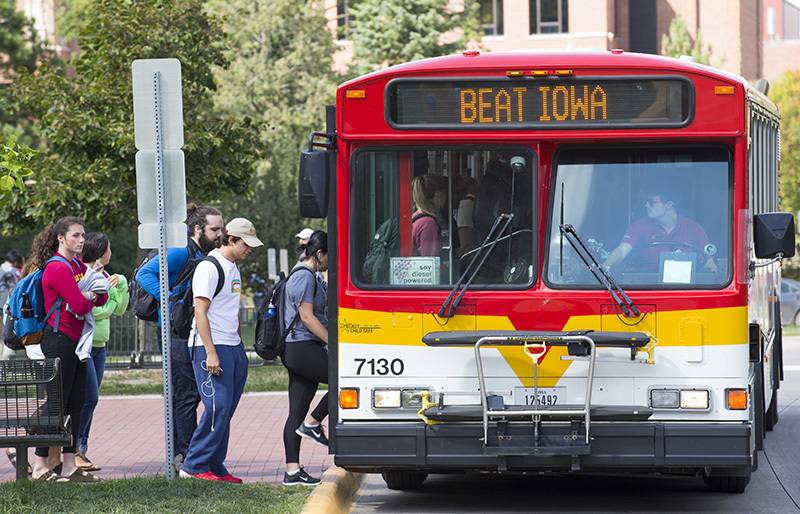
Photo by Christopher Gannon.
Iowa holds a 2-0 advantage in the 14th annual Iowa Corn Cy-Hawk Series, with volleyball and football on this week's schedule. Friday's volleyball match is in Iowa City, and the battle for the Cy-Hawk football trophy is Saturday in Jack Trice Stadium. Kickoff is 11 a.m. Fan information is available on athletics' Football Gameday Central website.
Saturday, Sept. 9
- 8-10:30 a.m., Cyclone Central tailgate, Alumni Center, entertainment and activities; food, refreshments and merchandise available for purchase; book signing by wrestling hall-of-famer Dan Gable (8:30-9:30 a.m.), free
- 11 a.m., Football vs. Iowa, Jack Trice Stadium, $90 and up
Karaoke with the carillon
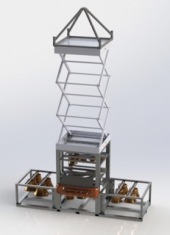
Miniature model of the portable campanile and carillon design. Submitted photo.
A two-year project to design and build a portable one-fifth scale model of the campanile -- with a playable carillon -- is nearing completion. A series of events is being planned for next week to raise funds for manufacturing the bells, model and trailer.
“This campanile-carillon model is truly a collaborative project showcasing our Cyclone spirit," said Tin-Shi Tam, ISU carillonneur and Cownie Professor of Music. "From fundraising to building the model, students, faculty and staff from different disciplines work together to make it happen. We want everyone to chime in and be part of this project."
The fundraising events will be held at the campanile from noon to 2 p.m. Sept. 13-15, and 5-8 p.m. Sept. 13 and 16 (updates will be posted online). They include:
- Karaoke with the carillon, choose from a list of classics or make a request for an additional charge, $50 per group (up to five people)
- Campanile tours, photos and ring the carillon's biggest bell, $10-$30
- Memorabilia sale, featuring one-of-a-kind carillon and campanile items, and 3-D printed models, $5-$100
- Lessons, learn to play the carillon, $30 for individuals or $50 for groups of two
Multidisciplinary student teams in Engineering and Design have been working on the project since the first class developed a design during the 2016 spring semester. The project should be completed by the end of 2018.
Tam plans to use the model for outreach activities, including demonstrations, music education and performances. About $60,000 is needed to complete the project.
Related story
- Class designs playable carillon model, April 28, 2016
